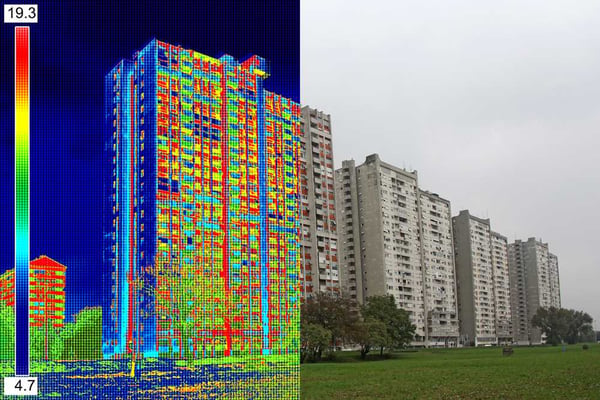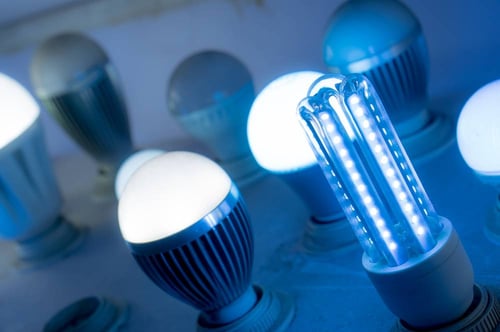Quick Measures to Improve a Building Energy Grade Under Local Law 33

Starting from 2020, NYC buildings with at least 25,000 sq.ft. will get energy grades from A to F, as defined by Local Law 33. In addition, there will be a legal requirement to display these grades where they can be easily seen by the public. This creates an incentive for property owners to improve efficiency, since tenants and visitors will be aware of building energy performance.
The main challenge is that building energy scores for 2020 will be calculated with data from 2019. Therefore, energy efficiency measures must be deployed early in 2019 to have a significant effect. This article provides energy efficiency recommendations that can be deployed quickly to boost energy grades. A recent blog post explains how energy grades work under Local Law 33.
Find the optimal energy efficiency measures for your building.
1) Get an Energy Audit and Building Recommissioning
Since every building is unique, the optimal combination of energy efficiency measures changes for each property. A professional energy audit can reveal the most promising opportunities to improve performance, boosting the energy grade in a short time.
-
After an energy audit, property owners get a detailed list of energy efficiency measures, with estimated budgets and savings.
-
To boost energy grades before 2020, property owners can prioritize measures that are affordable and quick to deploy.
Even with energy efficiency measures, MEP systems suffer a gradual loss of performance as their operating parameters deviate from the optimal configuration. Recommissioning consists on inspecting building systems to ensure correct operation, while adjusting sensors and controls. Minor reparations that are not capital-intensive may also be performed during the recommissioning process.

Retro-commissioning is basically the same procedure, with one important difference: recommissioning is understood as a commissioning process carried out at regular intervals, while retro-commissioning implies that the building has not been inspected in a long time.
The advantage of getting an energy audit and building commissioning is that you meet the requirements of Local Law 87, which mandates these procedures at 10-year intervals. At the same time, you are working towards a better grade under LL33.
2) Upgrade to LED Lighting
The optimal combination of energy efficiency measures is different for each building, but LED lighting is almost always an effective upgrade. LED upgrades can be completed much faster than many other energy efficiency measures, making them a viable option to boost energy grades before 2020.
Although there is a wide range of LED products in the market, there are three main types of lighting upgrades:
-
A relamp consists on replacing only lamps with equivalent LED products, while conserving the existing fixtures and their internal wiring.
-
A retrofit also conserves the existing fixtures, but their internal connections are rewired during the lamp upgrade.
-
A fixture replacement is a full lighting renovation. The existing wiring is normally reused, but the fixtures are completely new.
Fixture replacements tend to achieve the best performance, but they are also more expensive and slower. Relamps and retrofits are quicker, while still achieving significant savings.

An old and outdated lighting system can represent around 30% of building energy consumption. If LED lighting can reduce consumption by half in this case, the building uses 15% less energy. LED lighting becomes even more efficient when combined with automatic controls, such as occupancy sensors and daylight sensors.
With an LED upgrade, you are meeting part of the requirements of Local Law 88 while improving the energy grade under LL33. All buildings covered by LL88 must have lighting systems that meet the energy code by 2025, and the law also requires electricity submetering for tenant spaces.
3) Find and Seal Air Leaks in the Building Envelope
A building with uncontrolled air leakage forces heating and cooling systems to work harder, wasting energy throughout the year. Just like plumbing leaks increase water bills, air leaks increase heating expenses in winter and cooling expenses in summer.
Air leaks are invisible, but they can sometimes be felt as an unusually warm or cold spot inside a building. Consulting engineers can pinpoint air leaks very effectively with building pressurization tests and thermal imaging cameras. Once the main air leaks in a building have been detected, they can be fixed relatively quickly with caulking and weatherstripping.
4) Upgrade Electric Motors
Air handlers, pumping systems and other types of motor-driven equipment can consume a lot of energy throughout the year. However, motors can be upgraded quickly thanks to their standard dimensions - the changes required for other system components are minimal.
To achieve the best results with a motor replacement, the specific equipment to be upgraded must be chosen carefully. To maximize savings, motor replacements should focus on fans and pumps with long operating schedules.
-
Ideally, the new motors should have a NEMA Premium Efficiency rating.
-
Electronically commutated motors (ECM) are recommended for fractional horsepower applications, which are not covered by the NEMA rating.
Conclusion
The energy efficiency measures described in this article are quick, which means they can improve a building’s energy grade as early as 2020. However, the list of potential measures does not end there - HVAC upgrades in particular have a high energy-saving potential, but they require more planning and capital than the measures described above.
As previously stated, the best starting point to improve a building energy grade is a professional energy audit. This will provide a list of recommended measures for your building, along with technical and financial details.

Michael Tobias
Michael Tobias, the Founding Principal of NY Engineers, currently leads a team of 150+ MEP/FP engineers and has led over 4,000 projects in the US
Join 15,000+ Fellow Architects and Contractors
Get expert engineering tips straight to your inbox. Subscribe to the NY Engineers Blog below.

